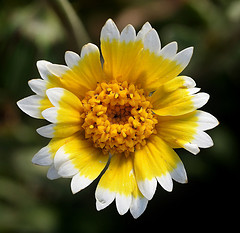
There’s no single trick to getting super sharp photographs. But, when you combine a bunch of little tricks, you’ll begin to notice some big changes in sharpness. So, here are seven little things you can do to inch your way towards sharper images:
#1 – Always use a tripod
I know–tripods are heavy, they take a long time to setup, and can cost a lot of money, but it’s nearly impossible to get sharp photographs without one. Nothing keeps your camera more still.
#2 – Enable mirror lockup
Normally, the mirror in your SLR will flip up immediately before the shutter opens, and this flip can make the camera vibrate a little. So, there’s a helpful setting on most SLRs called “mirror-lockup” and if you enable it (disabled by default on most cameras), then your camera will add a significant pause between the time the mirror goes up and the shutter opens, letting any vibration die down before the photo is actually shot. Look in your camera’s manual to find out how to enable this feature.
#3 – Use a remote shutter-release or timer
When you press the shutter button on your camera to take a photo, there’s a good chance you’ll shake the camera a little. To prevent this, use a remote control to release the shutter, or you can just use the timer on your camera (so any vibration you caused by pressing the button will die down before the shutter is actually released).
#4 – Increase shutter speed
When you increase your shutter speed, you leave the shutter open for a shorter length of time, so there’s less time available for the camera to shake. Before increasing shutter speed though, consider how it’ll affect your depth of field, noise levels (if you increase ISO), and/or exposure. The trade may not be worth it.
#5 – Use manual focus
Autofocus is great for moving subjects or when you need to take photos quickly, but when your subject is somewhat stationary (i.e. you’re shooting a beautiful landscape), you might want to use manual focus. This ensures you’re focusing on the right subject, at the proper distance.
#6 – Shoot lots and lots of photographs
When shooting wildlife or any kind of fast moving subject, the best way to get a super sharp photo is to simply take lots and lots of shots. This helps increase your chances of getting a shot when your subject was still or when your camera was accurately tracking your subject.
#7 – Use the sweet spot of your lens
Most lenses are sharpest in their “mid ranges” and about two stops below their widest aperture. For example, if your 17-40 mm zoom lens has a speed of f/4, then you’ll probably get the sharpest results from using f/8 and zoomed at 30 mm. Very rarely are lenses sharp on their borderlines. Also, fixed focal length lenses (also known as “prime” lenses) are almost always sharper than zoom lenses.
Get more great tips in our free weekly newsletter
 About the Author: Steve Berardi is a naturalist, photographer, computer scientist, and founder of PhotoNaturalist. You can usually find him hiking in the beautiful mountains and deserts of Southern California.
About the Author: Steve Berardi is a naturalist, photographer, computer scientist, and founder of PhotoNaturalist. You can usually find him hiking in the beautiful mountains and deserts of Southern California.
@Helmut – good point about the kit lens, it definitely is NOT very sharp.. a good step up would be the 50mm prime (cheap but sharp).
I like your site and tips but I’m frustrated trying to get sharp landscapes and would appreciate your guidance. You mentioned using 17-40 F4 that the sweet spot would be F6.3, yet we are “supposed” to step down to smaller apertures. F11 is usually the smallest opening that still retains good sharpness throughout. Will F16-22+ ever be usable for sharp landscapes? Also the rule of focusing 1/3 into frame is not easy if I have foreground to infinity in the frame. Is it better to manual focus by feet measurement on lens – and what # do I pick? I’ve failed much more than succeeded and need help. Thanks.
In regards to the landscape photography it depends on you and what results you would like to get out of your pictures. Take a look at my website at http://shutterbug.moonfruit.com. I am still learning just like everyone .
Hi i am new to photogpraphy…i am wildlife and nature lover, enthusiasist…i have recently purchased a sony a330, its a entry level, but good features,..i wanted to learn the terms involved in photography..so i chose sony a330 which had almost all professinal features…i want to enhance my camera with an 500mm f80 SAL lens..or let me know which is the best suitable for wildlife and nature….
Cheers…
charles
it helps me to good and sharp photographs tank u
I am considering a new lens for my Canon 350D. I am looking at the Canon EF 100-400mm f4.5-5.6L IS USM lens. I am shooting hawks, etc. Would you reccommend this lens or something comparable? I don’t have thousands of dollars to sink into a lens.
The purchase of two L lenses were a valuable addition, the 430EX2 flash added a marvelously new spectrum to my photoworld, the ND And CP filters are wonderful accessories, the single most valuable piece of equipment I’ve bought was a quality, sturdy tripod! It made so many photos achievable!
Though I don’t always carry it, I do bring it along as much as possible because it ensures my percentage of sharp photos is increased manyfold!
To add to the above points – Picture style plays an important role in sharpness. Again that depends on the subject you are clicking. For example, Standard will give more sharpness over portrait (if sharpness is considered over skin tone). Or else the user defined picture style can be used, with a bigger sharpness value. But this need to be chosen carefully, as it might affect the color.
Any tips on how to keep the camera steady underwater ?
@Gary
As an ex diving photographer, the best method was to ensure you are neutrally buoyant (when you breathe in/out you move up/down). Once you’ve got this when you take the shot, hold you breath, if you are mid stream not a lot else you can do. Obviously at the sea bed you can use a rock or something else dead! Holding breath at the point of shutter depression should help.
I read a good tip recently, in Backpacker. It’s no substitute for a tripod, but it does help some. If you shoot in burst mode, the shots in the middle of the burst will be a bit sharper. For me, someone who takes most of my shots while hiking, it’s proven to be pretty effective, though again, no substitute for a tripod, or even a fence post.
And when you need even more sharpness the best way I found in PP is to use the high pass filter at about 12 pixels and use a blend mode of hard light or if that’s too much the blend mode of overlay. There are Youtube videos on the subject.
One other thing I have done (and not often as it’s time consuming) is to enlarge the photograph in Photoshop to a pixel view and change some of the pixel colors. I shot a flower on a black background and was very hapy with it except for one small area of focus right at the tip of a petal. I changes a few pixels to black instead of blurry and got a significantly better image, infact it was a top scoring photo at the club I belong to.
That’s quite useful tips.
Even using tripod I found that 2 sec timer does not work unless it is a very heavy tripod. In normal ones the vibration of camera after pressing shutter release dies down in about 3-4 sec with the center column down. With the column up it can be around 7 sec. this means the camera would be shaking even when the timer ha timed out and photo can be ruined.
Using a cable release is the best option even with 2 sec timer. Else use 10 sec timer.
Great tips! For Sharpening your images in Photoshop there’s some useful information here
http://futurephoto.weebly.com/essential-retouching.html
.I like your article very much.
I am using a sigma 150×500 mm lens. What is my best aperture setting for most wildlife images? Assume I am shooting a fixed subject at 50 to 100 feet. I have used a custom settings: Maximum ISO of 3200, f/5.6, and minimum shutter speed 800.
When you get your “good” tripod, please remember to couple it with a “good” tripod head, otherwise a waste of time and money.
Just like getting a Nikon D800 and putting an average lens on it, another waste of time and money.